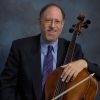
The Joy of Feuillard – A Sequential Approach to Teaching Bow Technique (Part 27 – Feuillard No. 35 – Variations #26-41)
Robert Jesselson
The Variations in today’s Blog all deal with staccato and legato strokes across three strings in various combinations. The string crossings should all be executed with the upper arm. Because they are to be played in the middle of the bow the staccato strokes should be played with the lower arm. We should pay attention to the “catch and float” on all these staccato strokes: “catch” the string at the beginning of each note, and then “float” to release the sound for resonance. Each note should have a nice starting “k” sound.
Variations #26 – #31:






After he played Variation #26 fully (with four beats per measure) I asked Zach to only play two beats for each chord in order to save a bit of time in the lesson. By now his ability to concentrate and maintain focus has improved greatly, and I know that he is practicing with all the repetitions at home. So I am comfortable with him playing one or two variations with the full value, and then halving them to save time.
What you don’t see in these videos is that we spent a good bit of time in this lesson trying to improve the quality of his staccato sound – especially listening for the “ring”, and finding the “catch and float”. We also worked a bit on the intonation of his “D’s” on the A string, which were often flat. I asked him to listen for the “ring” on the D’s, and to be careful that his contact point was in the right place for that note. Since the string length is shorter when playing the D it could be that his pitch was suffering from “bow intonation”, in which the incorrect contact point is too high and the bow actually bends the string with the weight being applied. If the contact point is in the wrong place it will change the pitch and we might think that the intonation problem was caused by the left hand.
Variation #31 is the only one that has no dots on the notes. I think it might be an editorial mistake (similar to No. 32, Variation #14 which is clearly a misprint). Zach asked me about this – having noticed that the dots were missing. I asked him to play it with the dots, and then also without the dots, since he had practiced it that way. I was pleased to see that he had observed the editorial discrepancy – that is a sign that he is paying more attention to details.
Variations #32 and #33:


These variations involve legato string crossings with the upper arm. We have to be careful to use a high contact point for the lower strings, and a low contact point for the higher strings in order to get the same sound and volume. Notice that Zach is using left/right motion, and the twist motion, especially in #33 (after I reminded him! But the good news is that he is able to do the choreography now).
Variations #34-#36:



These variations all have one staccato note together with two legato slurred notes in various combinations. I worked with Zach on getting the bow angle to be correct on the upbows.
As we know, getting the correct bow angle (parallel to the bridge) is a big problem for cellists, and it involves a lot of moving parts in the arm. At first the issue for most people is bowing “out” to the tip – we must counteract the natural swing of the arm around the shoulder joint which makes the bow angle back too far. It takes quite a lot of perseverance on the part of the student – and the teacher! – to get that right. Likewise, at the frog it is difficult to get the angle so that the tip of the bow is not pointing back. This requires adjustments with the wrist and fingers. After a while students get it “somewhat” right, but maybe not in all situations. The string crossings add a new element to the bow angle problem, since each string requires a slightly different path for the arm and hand. So, we need to address the same issues again. I find that many students are better at either the frog or the tip – but we must work to make both ends of the bow correct. With Zach, the issue was at the frog, and I needed to remind him to use the wrist and fingers to make the adjustment.
Zach played Variation #36 on a different day a little slower because he was trying to avoid accenting the single bows. During the lesson he figured out that he needed less weight on the staccato note.
Variations #37 and #38:


Continuing with the staccato strokes, Zach noticed that Variation #37 is missing a dot over one of the notes. This is obviously an editorial mistake – there are several minor ones in the Schott edition, as we have seen before. I was pleased that once again Zach caught the mistake – it means that he was looking more carefully at the details and noticing the discrepancies. That often translates into noticing details about one’s own playing, and listening better to what is actually coming out in the playing.
Variation #38 should be done two ways: up-bow staccato and flying spiccato. I was pleased to see that Zach remembered to do it both ways, and that he knew the technical differences in executing the two different strokes.
Variations #39 – #41:



These are the last three variations in this group of triplets involving string crossings with alternating legato and staccato strokes. In Variation #40 I again asked Zach to do both the up-bow staccato and flying spiccato strokes.
Next week’s Blog will explore various combinations of the upper arm and the wrist/fingers for a variety of complicated string crossings.
*If you have questions or comments about The Joy of Feuillard, Dr. Robert Jesselson can be reached directly at rjesselson@mozart.sc.edu.
Subjects: Repertoire, Technique
